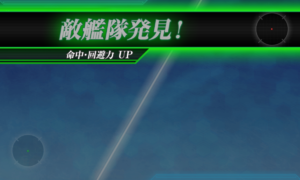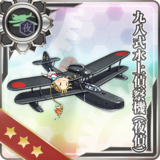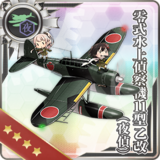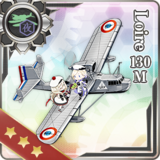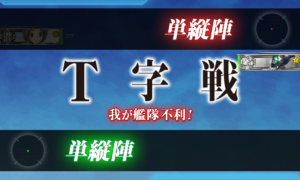- Welcome to the Kancolle Wiki!
- If you have any questions regarding site content, account registration, etc., please visit the KanColle Wiki Discord
Difference between revisions of "Combat/Day Battle"
Jigaraphale (talk | contribs) m (→Engagement) |
|||
| Line 57: | Line 57: | ||
|- | |- | ||
|Parallel Engagement<br>{{Nihongo|同航戦|''Doukousen''|}} | |Parallel Engagement<br>{{Nihongo|同航戦|''Doukousen''|}} | ||
| − | |'''Parallel ''' | + | |'''Parallel''' |
|100% | |100% | ||
|45% | |45% | ||
| Line 74: | Line 74: | ||
* Engagement modifier affects all aspects of Shelling Phases, as well as the Battle Opening and Closing Torpedo Salvos. | * Engagement modifier affects all aspects of Shelling Phases, as well as the Battle Opening and Closing Torpedo Salvos. | ||
* All engagement forms affect both sides equally, including crossing the T (Advantage or Disadvantage). | * All engagement forms affect both sides equally, including crossing the T (Advantage or Disadvantage). | ||
| − | * Equipping a {{ | + | * Equipping a {{YellowPlane}}{{Equipment/Link|Saiun|Saiun (Eastern Caroline Air Group)|Saiun (4th Recon Squad)|text=Saiun}} will override {{color|red|'''Red T'''}} engagements and turn them into '''Head-on''' engagements instead. |
| + | ** This mechanic does not work if the Saiun is in a zero plane slot. | ||
=Shelling Phase= | =Shelling Phase= | ||
Revision as of 16:34, 8 December 2022
Day Battle Breakdown
The Day Battle is the phase where the majority of combat takes place. This article will go more in-depth on the stages that take place in Day Battle.
Although it will be mentioned when the other related battle phases take place, keep in mind that this page will not go more in-depth about it due to the complexity of the mechanics behind them. Instead, check each's own article page.
The Day Battle has the following structure:
- Detection
- Engagement
- First Shelling Phase
- Second Shelling Phase
- Closing Torpedo Salvo
Other phases that may happen during Detection and Engagement:
In case neither fleets meet the requirements, the sub-phase will be skipped.
Detection
During Detection, the fleet attempts to detect the enemy fleet. The success rate of Detection is influenced by many factors such as the number and quality of Recons, Radars, fleet Line of Sight (LoS), and such. It is not required to have any equipment to have successful Detection. Generally, it is extremely unlikely to fail detection unless using a very low leveled fleet.
Planes that participate in this phase:

 Sp Carrier Recons
Sp Carrier Recons Recon Seaplane Recons
Recon Seaplane Recons
 Bomber Seaplane Bombers
Bomber Seaplane Bombers Large Flying Boats
Large Flying Boats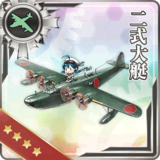
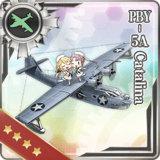
In case the fleet fails to detect the enemy fleet, the fleet will not participate in the Aerial Combat Phase.
Regardless of Detection success, the recons may also be shot down if the enemy fleet has significantly more fighters than equipped recons and the fleet contains no Carriers.
Although the displayed message indicates that Accuracy and Evasion have changed, testing has shown that it has no noticeable effect.
Enemy Abyssal fleets always succeed in Detection. PVP opponents however may fail detection, and therefore not launch planes in Aerial Combat.
Engagement
Before the battle proper begins, the game will roll one of 4 possible engagements:
| Form | Common name | Damage Modifier | Chance |
|---|---|---|---|
| Crossing the T (Advantage) T字戦有利 (T Ji-sen Yuuri?) |
Green T | 120% | 15% |
| Parallel Engagement 同航戦 (Doukousen?) |
Parallel | 100% | 45% |
| Head-on Engagement 反航戦 (Hankousen?) |
Head-on | 80% | 30% |
| Crossing the T (Disadvantage) T字戦不利 (T Ji-sen Furi?) |
Red T | 60% | 10% |
- Engagement modifier affects all aspects of Shelling Phases, as well as the Battle Opening and Closing Torpedo Salvos.
- All engagement forms affect both sides equally, including crossing the T (Advantage or Disadvantage).
- Equipping a
 Saiun
Saiun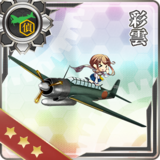
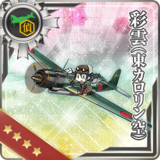
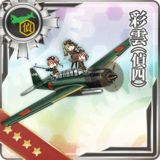 will override Red T engagements and turn them into Head-on engagements instead.
will override Red T engagements and turn them into Head-on engagements instead.
- This mechanic does not work if the Saiun is in a zero plane slot.
Shelling Phase
Following engagement, each side will begin the Shelling phase. A ship's single attack, carrier plane sweep, or ASW attack, as well as Artillery Spotting and Special Attacks are shelling attacks.
Some rules are applied for shelling attacks:
- Standard and Light Aircraft Carriers (CV and CVL) are unable to shell if they are moderately damaged (中破) or heavily damaged (大破). This includes Installations that are of the Aircraft Carrier (CV) and Aviation Battleship (BBV) types.
- Armored Aircraft Carriers (CVB) are only unable to shell when heavily damaged (大破) instead.
- Aircraft Carriers will not attack if they have no bombers or the equipped bombers' slots are reduced to 0 during the sortie.
- Ships that are able to attack submarines are forced to attack submarines as long there's at least one submarine alive.
- Exceptions being Suzuya Kou Kai Ni and Kumano Kou Kai Ni.
- Ships may perform special attacks denominated Artillery Spotting and Special Attacks, if applicable.
The firing order is defined when each of the Shelling Phase subphases starts, and will skip over sunk and retreated ships, or ships that have no means of attacking under any circumstances, such as a carrier with no bombers equipped, a submarine, or a Wa-Class Transport Ship, for example.
If a ship would normally be able to attack but currently is unable to, such as a carrier that is moderately damaged (中破) or lost all its equipped bombers, their turn will still be accounted for in the turn order. Ships that are unable to attack during their turn or sink before their turn will still take actionless turns.
First Shelling Phase
In this phase, both fleets will take turns shelling the opposing fleet, with the turn order defined by each ship's range ![]() stat. It's possible to increase a ship's range with proper equipment.
stat. It's possible to increase a ship's range with proper equipment.
The shelling order is Longest > Very Long > Long > Medium > Short > None.
If two or more ships tie for range, the order between them is random.
- Longest range is only attainable on Souryuu Kai Ni, Hiryuu Kai Ni, Ise Kai Ni, and Hyuuga Kai Ni, using range extenders (see Range Extension).
- Unlike the other ranges, Longest does not have a proper in-game icon and so is just displayed as "Very Long".
- "None" range is mostly reserved for Abyssal Aircraft Carriers and Transport Ships.
Second Shelling Phase
This phase will only occur if either side of the battle has any kind of Battleship present. The Battleship doesn't have to be alive for this phase to trigger.
In this phase, both fleets will take turns shelling the opposing fleet, with the turn order defined by the fleet order.
Closing Torpedo Salvo
After the Shelling Phase, any ship with a ![]() torpedo stat higher than 0 that is no more than lightly damaged (小破) will fire a Closing Torpedo. Each torpedo will target a surface ship at random and all torpedoes will strike both sides at the same time. After the Closing Torpedo Salvo, the Day Battle is over.
torpedo stat higher than 0 that is no more than lightly damaged (小破) will fire a Closing Torpedo. Each torpedo will target a surface ship at random and all torpedoes will strike both sides at the same time. After the Closing Torpedo Salvo, the Day Battle is over.
- Submarines and Installations cannot be targeted.
- Ships must have a base
 stat greater than 0 to attack.
stat greater than 0 to attack.  stats from equipment do not count.
stats from equipment do not count. - See Damage Calculations and Accuracy, Evasion and Criticals for calculation details.
- It's been observed that during Combined Fleet vs Combined Fleet (12 vs 12) and Player Single Fleet vs Enemy Combined Fleet (6 vs 12) scenarios, the player side torpedoes will resolve their damage before Abyssal side torpedoes, causing Abyssal torpedo power to be lowered if the Abyssal is Medium Damaged, or reduced to zero if Heavy Damaged or sunk (causing only scratch damage if it hits), in the same way a damaged ship firing opening torpedoes is handled.
Aftermath
If any of the enemy ships are still alive after Day Battle ends, a prompt asking if the player desires to pursue the enemy fleet into Night Battle will appear. Accepting this prompt will move the battle to Night Battle, starting with the conditions on which the Day Battle ended.
If the Day Battle was preceded by a Night Battle in the same node, such a prompt will not appear, and the battle will automatically end instead.
See Also
| |||||||||||||||||||||||||||||||||||||||||||||
